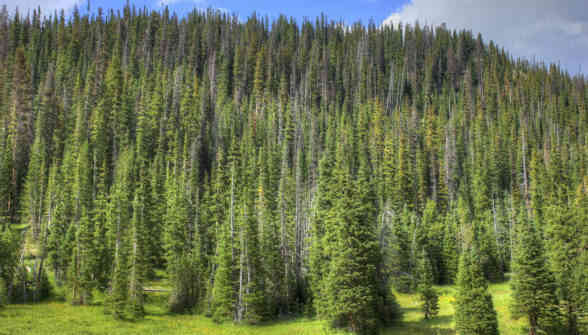Forests — green lungs of the planet, and coniferous trees perform their natural function all year round, since they do not shed needles for the winter, replacing their leaves. The air in such places is really healing — remember how easy it is to breathe in a pine forest! Therefore, forests must be protected, and not cut down as barbarously as it is done now.
Interesting facts about coniferous forests
- Most of all coniferous forests on the planet are located in the taiga zone in the north Eurasia and the North American continent.
- Coniferous forests of Australia mainly consist of plants of the genus Podocarp — it includes shrubs up to a meter high, and huge trees, whose tops are separated from the ground up to 45 meters (interesting facts about Australia).
- Artificial coniferous forests began to appear in Europe and North America from the end of the 17th century. In the Old World, lands that had undergone intensive felling were specially planted with coniferous trees, since no other plants would have taken root there. North Americans, on the other hand, massively cut down deciduous trees for their valuable wood, as a result of which their coniferous counterparts began to predominate in the forests.
- Coniferous taiga with an area of 15 million square kilometers is the largest biome on the planet, located on land. It is also the largest landscape zone in the Russian Federation. Its width in the west of the country is 800 km, and in Siberia it reaches 2150 km.
- Over 300 species of birds build nests and raise chicks in coniferous taiga forests. In addition, nowhere on Earth, except for the taiga, does such a number of fur-bearing animals live (interesting facts about birds).
- Over 32,000 species of insects are found in Canadian coniferous forests.
- The Siberian coniferous taiga is called the green “lungs” of the Earth, since the balance of oxygen and carbon in the near-Earth atmospheric layer depends on the state of this forest.
- Trees in larch forests coniferous forests can reach a height of 80 meters. At the same time, larch is considered the most common forest-forming tree species on Earth (interesting facts about trees).
- During fires, trees in larch forests almost always die – unlike, for example, pines, which often manage to survive natural disasters. At the same time, due to the especially strong wood, burnt trees do not fall and do not rot, and a dead forest can stand unchanged for many decades, until new plants appear in this place.
- Forests of tree-like junipers, which usually grow on the slopes of mountains, prevent the shallowing of mountain rivers and the occurrence of mudflows.
- The East Siberian taiga is the world’s largest expanse of untouched forests. The maximum length of this region from north to south is 1600 km. Here, in its original form, one of the most extensive habitats of many animal species has been preserved.
- Firs can reach a height of up to 100 meters and have a trunk diameter of up to 2 meters. The average lifespan of these trees is two hundred years, although some species of fir live up to 500-700 years.
- In the undergrowth of South American coniferous forests, holly grows, from which mate is prepared, or Paraguayan tea is one of the most popular drinks on the continent.
- Araucaria coniferous forests, located in subtropical regions, covered an area of 200 thousand square kilometers by the end of the 19th century, but now they are on the verge of extinction due to massive cutting down of trees for their valuable wood. In recent years, the felling of araucaria has been completely banned.
- The Canary Islands have coniferous forests formed by a tree species that is not found anywhere else on the planet – the Canarian pine.
